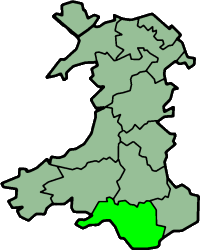Glamorgan
| Glamorgan Welsh: Morgannwg |
|
|---|---|
 Flag adopted in 2013 |
|
 Ancient extent of Glamorgan |
|
| Area | |
| • 1861 | 547,494 acres (2,215.63 km2) |
| • 1911 | 518,865 acres (2,099.77 km2) |
| • 1961 | 523,253 acres (2,117.53 km2) |
| Population | |
| • 1861 | 326,254 |
| • 1911 | 1,120,910 |
| • 1961 | 1,229,728 |
| Density | |
| • 1861 | 1.7/acre |
| • 1911 | 2.2/acre |
| • 1961 | 2.4/acre |
| History | |
| • Succeeded by |
West Glamorgan Mid Glamorgan South Glamorgan |
| Chapman code | GLA |
| Government | Glamorgan County Council (1889–1974) |
| • HQ | Cardiff |
| • Motto | A Ddioddefws A Orfu (He Who suffered, conquered) |
 |
|
| Kingdom of Morgannwg | ||||||||||||||||
| Teyrnas Morgannwg | ||||||||||||||||
|
||||||||||||||||
| Capital | Various | |||||||||||||||
| Languages | Welsh | |||||||||||||||
| Government | Monarchy | |||||||||||||||
| King | ||||||||||||||||
| • | 942 - 974 | Morgan Hen ab Owain | ||||||||||||||
| • | 1063 - 1074 | Cadwgan ap Meurig | ||||||||||||||
| • | 1081 - 1091 | Iestyn ap Gwrgan | ||||||||||||||
| Historical era | Middle Ages | |||||||||||||||
| • | First union of Gwent and Glywysing | 942 | ||||||||||||||
| • | Union disestablished | 974 | ||||||||||||||
| • | Kingdoms reunited | 1063 | ||||||||||||||
| • | Conquered (by the Norman lord, Robert Fitzhamon) |
1091 | ||||||||||||||
|
||||||||||||||||
| ^ | ||||||||||||||||
Glamorgan (/ɡləˈmɔːrɡən/) or, sometimes, Glamorganshire (Welsh: Morgannwg [mɔrˈɡanʊɡ] or Sir Forgannwg [ˈsiːr vɔrˈɡanʊɡ]) is one of the thirteen historic counties of Wales and a former administrative county of Wales. It was originally an early medieval petty kingdom of varying boundaries known as Glywysing until taken over by the Normans as a lordship. Glamorgan is latterly represented by the three preserved counties of Mid Glamorgan, South Glamorgan and West Glamorgan. The name also survives in that of Vale of Glamorgan, a county borough.
Although initially a rural and pastoral area of little value, the area that became known as Glamorgan was a conflict point between the Norman lords and the Welsh princes, with the area being defined by a large concentration of castles. After falling under English rule in the 16th century, Glamorgan became a more stable county, and exploited its natural resources to become an important part of the Industrial Revolution. Glamorgan was the most populous and industrialised county in Wales, and was once called the "crucible of the Industrial Revolution," as it contained the world centres of three metallurgical industries and its rich resources of coal.
...
Wikipedia
